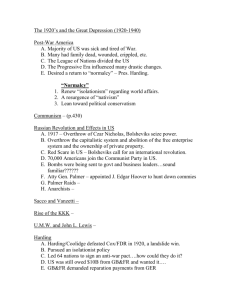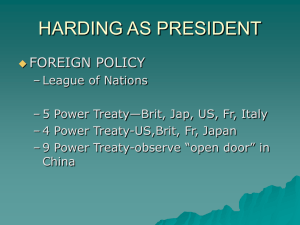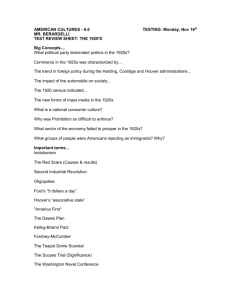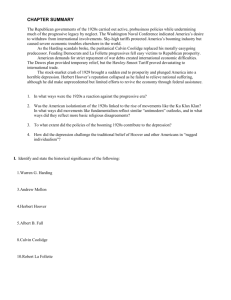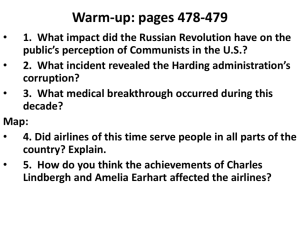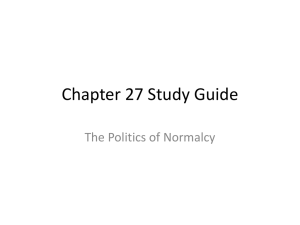1920s and 30s Boom and Bust
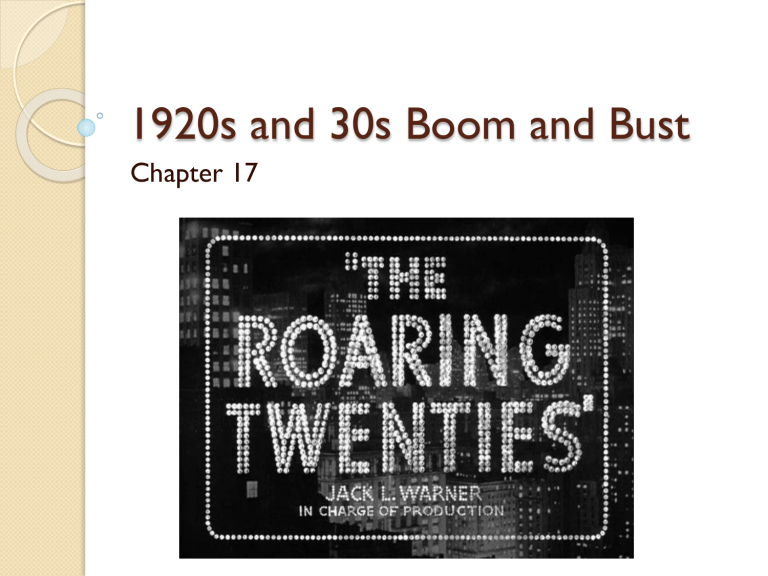
1920s and 30s Boom and Bust
Chapter 17
The New Economy
Wars are great for the economy (as long as you aren’t fighting at home) There was a brief recession as the war ended, but from 1923-29 there was widespread prosperity and expansion- due in part to the fact that we were the only major econ left standing after the war…..
Business glorified again- Calvin Coolidge said “the man who builds a factory builds a temple”.
Economy was shifting- industry was becoming based in consumer goods (ready made clothes, appliances, electronics etc…) Prices had dropped, wages had risen; Americans had to spend far less on “necessities” and had more to spend on
“luxuries”. Industrial productivity rises 70%
White Collar Workers Increasing- in 1900 18% were, by
1930 44% were
Transportation
We are entering the age of the automobile. Model
T introduced in 1908, and prices went down as manufacturing became more efficient. By 1920 you could buy one for $400, or pay for it on credit.
During the 1920s 23 million cars will be purchases- which will radically change American family and social life.
Airplanes invented in 1903- and used in WWI
(flying “aces”) Charles Lindbergh’s solo flight 1927 made him a national hero (with a dark side….)
Amelia Earhart did it in 1931.
Electricity and Radio
Also hallmarks of the new consumer economy. By 1930 2/3 of homes had electricity ( as opposed to 20% before the war ) which could be used not only for light, but appliances like washing machines, refrigerators, vacuums etc…, and ½ had telephones.
Again, prices for these products were dropping, so things that had been
“luxuries” became commonplace
New Production Methods and
Selling Techniques
Henry Ford’s great contribution wasn’t really the car…it was the assembly line…industrial output grew by 40% in the 20s. He increased worker’s salaries from $2 a day to $5 a day if they would develop “thrifty” habits- and kept spies around to make sure no one was slacking on the job.
Though the era of the “trust” is over- the war had encouraged consolidation of major industry, so there were often large corporations dominating particular markets.
“Chain Stores” also became more common- like
A &P grocery or Woolworths five and dime.
Credit
New concept- the installment plan.
During the 1800s the focus had been on thrift and saving, now consumers are encouraged to buy with “no money down”
Advertising
Another burgeoning industry. Buy something not because you NEED it, but because you WANT it and “You’re worth it”.
Celebrity endorsements, (esp moviestars) catchy slogans, impossible promises….advertising is here to stay
Radio
Guglielmo Marconi (Italian
Immigrant) invented radio in
1890 . 1 st radio station 1920 ( KDKA Pittsburgh ) broadcast presidential election of Warren
Harding. NBC founded 1926, CBS 1927by 1929 there were 10 million radios in the US
Huge with advertising- and allowed people to experience things as they happened.
Helped create a national culture- could be used for propaganda, entertainment, politics, almost anything. “Media” quickly becomes enormously influential.
Farmers and the New Economy
Mechanization meant that fewer people needed to be farmers, and migration to cities continued (majority of Americans became
Urban)
Farming also represented a ever decreasing proportion of the economy, only 12.7% in
1929. Not really able to take part in the new
“prosperity” of the consumer income- a gap is widening that will become very problematic when everything falls apart in the depression
Changing American Lifestyles and
Values
1920s witness the birth of a widespread popular culture that crosses class lines, age brackets, and regional zones. It was a little wild and crazy (reflecting the idea that the old world order had been destroyed in the chaos of war) and from this point- every generation pushes the boundaries
Fads and Fashions
This is the Jazz Age (named by F. Scott
Fitzgerald), with flappers, drinking (illegally) and smoking in public, dancing in shocking ways to shocking music (Louis Armstrong,
Duke Ellington and Ella Fitzgerald) all taking part in a “New Morality” that puts pleasure before all else, and opens up taboos.
Professional Sports players and Movie Stars become the the new American Heroes. Silly competitions (flag sitting)
Women’s Freedom
Before WWI Margaret Sanger published an article about how multiple pregnancies etc… were bad for women’s heath- and advocated gov’t distribution of birth control. (contraception had been against the law since 1873)
Opened the 1 st family planning clinic in 1916
(jailed) 1921 founded American Birth Control
League (Planned Parenthood)
Freud’s theories about sexual repression causing emotional/mental problems (esp for women) were widely believed- therefore expressing greater “physicality” was healthy….
The Women’s Movement
19 th Amendment approved in
Congress in 1919- ratified in
1920
But while women had the vote, most Americans did not question that they should remain in their traditional subordinate roles. Many felt that women needed additional legal “protections”, to prevent long work hours, or force men to pay child support.
Divorce laws liberalized in many states- with preference for child custody going to the mother 1 in
6 marriages ends in divorce in the 1920s .
Equal Rights Amendment proposed in early 1920s by
Alice Paul- proposed eliminating all legal distinctions based on sex. Failed (as it did in the 1970s too)
Conflicts Between Old and New
Values
Obviously not everyone was going to jump on board with new ideas…
One group strongly opposed were
Evangelical (Born Again) who resented the secular nature of the age, and the pushing of boundaries away from biblical standards
Fought hard when pushed to try and maintain “traditional values”
Scopes Trial
In 1925 a Biology teacher named John Scopes was arrested in Tennessee for teaching evolution (which many felt was representative of a “moral breakdown” in US Christian values- ACLU had asked for a teacher to challenge in order to get the case)
Trial became a national sensation- and debate about freedom of thought. Clarence Darrow (pro) vs. William
Jennings Bryan (against)- broadcast on the radio.
Scopes found guilty, but case essentially disappeared.
Evolution became more accepted in schools. (still controversial in some)
Prohibition
The last of the great progressive reforms- 18 th amendment passed in 1919, prohibiting the sale of alcohol. Unfortunately the age of reform had passed, and people weren’t really interested in restriction- they are interested in pushing boundaries- and this became one more thing to rebel against
Volstead Act: set criminal penalties for sale- and created Prohibition Bureau within the Treasury
Department.
At first it seems to go well- by 1921 alcohol consumptions drops to 1/3 of where it had been in 1914…. But…
Problems with Prohibition
It’s hard to enforce a ban on something most people don’t think of as a real crime, plus there are loopholes. Doctors can “prescribe” alcohol, and it wasn’t a crime to manufacture or drink- just sell (bathtub gin)
People still want alcohol, and were there is a demand, a supply will follow. Bootlegging became a huge business, bars become “speakeasies”.
Organized crime really born in US during 1920s- gangsters like Al Capone/Lucky Luciano made $$ off illegal alcohol, and took care of competition however they needed to- over 500 gangster related murders in Chicago in the 1920s, and once prohibition ended, gangsters moved on to gambling, prostitution, drugs etc …
Bu 1929 alcohol consumption was 70% of what it had been in 1914- and the Volstead Act was a national joke
Red Scare
The Bolshevik Revolution in Russia, and communist movements in general
really freaked people out in the 20s (so much so they ignored the larger threat of Fascism as it rose) There were about 70,000 members of the US communist party in 1920. Transfer existing fears about
“new” immigrants to this group.
In 1919 there were a series of violent strikes and labor disputes
(Seattle General Strike, Boston Police Strike, United Mineworkers
Strike)blamed on radicals (as the Haymarket riots had been) And a mysterious series of threats on the government ( 30 bombs sent through the mail- no one killed or seriously injured ) and suddenly people see “communists” behind every tree- Witch hunt mentality
Attorney General Mitchell Palmer determines to “stamp out” the communist movement- Palmer Raids arrest 6000 people- 500 of whom (mostly Russian) are eventually deported.
Sacco and Vanzetti
1921 Most publicized
“red” case- and a representation of how fear throws reason out the window.
Nicola Sacco and Bartolomeo Vanzetti (Italian immigrants) arrested for the murder of a factory guard in Massachusetts. The main
“evidence” against them was that the men were known to be anarchists, atheists and draft dodgers . Sentenced to death in 1927- probably innocentcase overturned in 1977
Nativism, Immigration and Racism
Red scare led to calls to restrict immigration- esp from southern and eastern Europe who are thought to be polluting “native” values ( good news is- we now like
Germans and Irish whom original “know nothings” had protested )
1921 Immigration Act : Congress limited immigration to
350,000 people a year, 1924 National Origins Act lowered to
164,000. It also set “quota system” saying that of those people allowed to come it could only represent 2% of that country’s immigrants in 1890 (heavily favoring western
Europeans) Cut immigration in half- actually more people left the country in 1930 than arrived.
No limitations on immigration from other parts of the
Americas- significant numbers of Mexicans (they had a revolution in 1910- hot mess) and French Canadians arrive
Decline of the Labor Movement
Unions became associated with socialism
(which they are), communism and other
“radical” elements. After all, workplaces are much safer now (after progressive reforms) what else do workers need? Bloody summer of 1919 had seen 4 million workers on strike- and cost them public support.
Many states passed open shop laws forbidding unions from forcing membership, and businesses created blacklists of “union agitators”
KKK
Revived in the 20s ( Birth of a
Nation 1915- great recruiting film- and 1 st “blockbuster” movie in history )- targeting not only African Americans, but immigrants, esp Communists,
Catholics and Jews (you have to be a WASP to be KKK)
In 1925 there are 5 million klansmen- who make no effort to hide activities saying that they are “cleansing” society (they are an extremist reaction to Jazz age shifts in morality)
Eventually their violence (along with some other scandals like embezzlement) will discredit
The Lost Generation
Many people who had survived the war found themselves struggling to create a place in the world. Traditional values no longer seemed solid, emerging culture seemed shallow after all they had been through – what had all that death and sacrifice been about? Quest to find meaning inspired great art, esp in literature
Great writers:
◦ TS Elliot- the Waste Land (a collection of poems about pessimism of the modern world)
◦ F Scott Fitzgerald- The Great Gatsby (the glamour and cruelty of materialistic society)
◦ Sinclair Lewis – Main Street (debunked small town hypocrisy)
◦ Ernest Hemingway- A Farewell to Arms (disillusionment of WWI)
Ex-patriots- many young intellectuals left their homes to move to artist colonies in the west (Santa Fe) or Paris
(Getrude Stein)
Harlem Renaissance
The same feelings of confidence and despair that existed in society overall could be found in the African American community as well.
Had fought, worked, and still were not being allowed to move forward in society.
So they decide to stop “apologizing” and revel in their own culture
“I am Negro, and I am beautiful”. Creators of Ragtime (Scott Joplin) and Jazz (Louis Armstrong, Duke Ellington) Moved north from
New OrleansA generation of artists and writers made Harlem
( Cotton Club ) a center of poetry, music, and art that came from
African inspiration ( Chicago important as well )
Langston Hughes- poet, voice of Harlem, disillusioned with society, but proud of culture.
Marcus Garvey- Political leader. United Negro Improvement
Movement- promoted return to Africa, which didn’t happen often, but spoke of racial pride, reclaiming roots, and separation by choice as superior group.
The Politics of Prosperity
Political Pendulum (I like alliteration) swings away from progressive idealism, especially as it is discredited by the struggles of prohibition, and towards a business 1 st approach.
Republicans control the white house and congress through the 20s, ushered in by
Warren G Harding’s promise of a return to
“normalcy”. This is where Republicans, the party of reform under TR and Taft, become more of their modern conservative selves
(the progressive element had bolted in 1912)
Presidential Rankings: C-Span Survey, 2009
1.
Abraham Lincoln
2.
Franklin Roosevelt
3.
George Washington
4.
Theodore Roosevelt
5.
Harry Truman
6.
John Kennedy
7.
Thomas Jefferson
8.
Dwight Eisenhower
9.
Woodrow Wilson
10. Ronald Reagan
11. Lyndon Johnson
12. James Polk
13. Andrew Jackson
14. James Monroe
15. Bill Clinton
16. William McKinley
17. John Adams
18. George H.W. Bush
19. John Quincy Adams
20. James Madison
21. Grover Cleveland
22. Gerald Ford
23. Ulysses Grant
24. William Taft
25. Jimmy Carter
26. Calvin Coolidge
27. Richard Nixon
28. James Garfield
29. Zachary Taylor
30. Benjamin Harrison
31. Martin Van Buren
32. Chester Arthur
33. Rutherford Hayes
34. Herbert Hoover
35. John Tyler
36. George W. Bush
37. Millard Fillmore
38. Warren Harding
39. William Harrison
40. Franklin Pierce
41. Andrew Johnson
42. James Buchanan
The Harding Years
Believed in cooperation between business and government- with gov’t main job being to help business make $$.
Harding himself was one of our more “ordinary” presidentsand that was his appeal. The public was tired of big personalities and crusades and speeches…Harding was just a normal guy.
BUT… he also did a little spoils system…. And while some were good administrators, others were known as the “ohio gang” and maybe weren’t good choices for public trust , several were implicated and convicted of bribes etc….and therefore Harding ends up fairly far down the list of
American leaders
In 1923 Harding died (natural causes- though possibly stress induced), and his VP Calvin Coolidge took over.
Teapot Dome and Arms Reduction
The biggest scandal came to light after Harding died.
Secretary of the Interior ( Albert Fall ) arranged for the transfer of naval oil reserves in Teapot Dome
Wyoming to his department, and leased the land to private contractors- accepting a bribe of $400,000 to do so. Secretary Fall ends up in prison
One of the best achievements of the Harding presidency was the Washington Naval Arms conference in 1922. League of Nations and US worked together to slow naval buildup, and create a ratio of ships for 5 major powers (US, Eng, Jap, Fr,
Italy) 5-5-3-1.7-1.7
Calvin Coolidge
Cabinet scandals did not scare people away from the Rep party, Coolidge won re-election easily in 1924
Nicknamed “Silent Cal”- he neither offered or achieved much change…kept tariffs high, taxes low, and businesses running smoothly. He was a believer in “trickle down” economics: keep things good for the rich (esp low taxes), and their wealth will be invested in business which will flow down to lower levels of society. Deliberately rejected programs that would help ordinary citizens or local issues, for ex, to help after a devastating flood that hit Mississippi, or building dams in Tennessee- these are jobs for local governments and charities- not the federal system.
Decided not to run in 1928 with the following speech “I do not choose to run”
Hoover in the White House
Republicans ran Herbert Hoover in
1928, who was well qualified to be president- had served with distinction as head of
Food Board in WWI and Secretary of Commerce for
2 administrations.
Radio speeches (national campaigning) significant for the 1 st time promising
“Poverty will be banished from the nation, there will be a chicken in every pot”…and the Democrats ran
Al Smith- a Catholic (Nativist uproar) Even a couple
southern states vote for Hoover!
As Hoover entered the white house in March of 1929 the US had never been more optimistic, more sure that they were heading towards and endlessly bright future…..
The Stock Market Crash: Roots
The Depression came from a variety of factors- a “perfect storm” of economic issues- and while the Crash was the explosion, it wasn’t really the start
Overproduction of Agriculture all through 20s- falling crops prices meant farmers were losing $$, and therefore less able to buy manufactured goods (so overproduction there too)
Many industries were weak- stuck in 1880s (cotton textile,
RR, coal- the backbones of the 2 nd IR).
Uneven distribution of income and taxation from trickle down. Unstable banking system with no federal protection.
Weak International econ b/c of war and tariffs
Speculation in stocks- with buying “On the Margin” (10% down, which only works as long as value of stock goes up)
Many people counseled caution- including Hoover
“Easy Credit” was too easy- people in debt
Results
A Recession began in
August of 1929, and then on
October 29 th 1929 (Black
Tuesday) a selling frenzy began- which led to a dip, then a crash ($30 billion in
“paper profits” lost in a month)…market and economy fall until rock bottom of July 1932
Major blame for gov’t comes not from letting crash happen…but for inactivity once it did….
Impact on Europe and Japan
As market had begun to stumble in early 1929, US had stopped making loans to Germany… which is how they had been paying their reparations to
France and England, which is how France and
England had been repaying their war loans to the
US (House of Cards)
As banks struggle in Europe and US with international $$ issues- they stop making loans to businesses, who then lay off workers, who then can’t buy goods
Japan also very hard it- heavily dependent on exports to US (they fix it by shifting to military production…)
Effect on the Economy
At first it seemed impossible…things had been so good for so long- which is one reason that there was such panic as the fall started (which helped the bottom drop out entirely)
By 1932- 5,761 banks (22%) had failed, and 20,000 businesses were bankrupt, business investment had dropped by 95%.
13 million Americans (25% of working population) were unemployed nationally- as high as 50% in certain areas- unskilled labor hit hardest
(unemployment had been 3.2% in 1929)
American confidence turns to despair
The Great Depression
Remember- Adam Smith says this is perfectly normal, and laissez faire capitalism is the American way (at that point) so gov’t should just ride it out, and things will take care of themselves eventually (the Depression actually ends up discrediting and destroying this as a viable theory)
The Dust Bowl
(on the next page of your outline)
Because things weren’t challenging enough….
In 1930 nature had thrown the US a curveball with a period of severe drought that destroyed topsoil layer in OK. TX, KA and CO.
Displaced over 1 million farmers “okies” who moved west.
(Grapes of Wrath)
Hoover’s Policies
Hoover is a Laissez Faire guy- and he genuinely thinks government “Interference” in the econ crisis will hurt
American character he calls “Rugged Individualism”
(determination overcomes adversity) Advocated
“Volunteerism” urging all citizens to contribute to charities to ease suffering (he donated generously) and asking business to economize where possible
Raises the Tariff (Hawley Smoot Tariff 60%) to protect
US Business, which actually made things worse as it restricted trade
So as the economy continued to freefall….he did very little (though he did try, and paved way for new deal)….
which is what puts him near the bottom of the list…..
Pump Priming
Hoover did feel that the gov’t could put a LITTLE $$ into the econ to jump start.
Gov’t hired people for public works projects (New Deal will do the same thing- just on a massive scale), Created an
Agricultural Marketing Act (Farm Co-ops) and The
Reconstruction Finance Corporation (RFC) to lend $500m to banks, who were then supposed to lend the $$ to start new businesses.
None of these programs were really successful, Hoover wasn’t willing to create gov’t debt, so didn’t spend enough for programs to be effective. And administered foolishly toogov’t would buy farm surplus, and throw it away rather than give “handouts”, or by cutting Bonuses to be paid to WWI veterans, 14,000 of whom then marched on DC in a “Bonus
Army” and occupied the capital- and were driven out by the
Army
Election of 1932
People are angry, and even though the Crash wasn’t
Hoover’s fault- the Depression seemed to be. And it happened to be the rock bottom of the depression.
Democrats nominated Franklin Roosevelt- Gov of
NY (TR’s 5 th cousin, there are lots of Roosevelts)
Campaigned aggressively, and personally, and like his cousin, it was his personality, vision, and
Optimism in the face of despair (“the only thing we have to fear is fear itself”) that would convince the people he should be president- won by a landslide, and is elected 3 more times
Presidential Rankings: C-Span Survey, 2009
1.
Abraham Lincoln
2.
Franklin Roosevelt
3.
George Washington
4.
Theodore Roosevelt
5.
Harry Truman
6.
John Kennedy
7.
Thomas Jefferson
8.
Dwight Eisenhower
9.
Woodrow Wilson
10. Ronald Reagan
11. Lyndon Johnson
12. James Polk
13. Andrew Jackson
14. James Monroe
15. Bill Clinton
16. William McKinley
17. John Adams
18. George H.W. Bush
19. John Quincy Adams
20. James Madison
21. Grover Cleveland
22. Gerald Ford
23. Ulysses Grant
24. William Taft
25. Jimmy Carter
26. Calvin Coolidge
27. Richard Nixon
28. James Garfield
29. Zachary Taylor
30. Benjamin Harrison
31. Martin Van Buren
32. Chester Arthur
33. Rutherford Hayes
34. Herbert Hoover
35. John Tyler
36. George W. Bush
37. Millard Fillmore
38. Warren Harding
39. William Harrison
40. Franklin Pierce
41. Andrew Johnson
42. James Buchanan
The New Deal
FDR’s plan to remake the
American Economy. A break with straight capitalism-
FDR follows the philosophy of John Maynard Keynes, who says that the best way to solve econ problems is for the gov’t to spend big $$, “investing” in the nation at a time when private business can or will not. To pay for programs, taxes go up, and so does the deficit.
Change is scary, and FDR was hated and loved by large segments of the population. Gave weekly addresses-
“Fireside Chats” on the radio where he would explain policy, and bolster confidence. Promises Americans the
“3 Rs” Relief, Recovery, and Reform
First 100 Days
March- June 1933.
Determined to hit the ground running. Called congress for a special session. Gathered a
“Brain Trust” of advisors and experts in addition to the
Cabinet ( Dollar a Year Men ) Looking for out of the box solutions- and planned to spend in ways the gov’t had never dreamed, not just jobs, but with social welfare and safety net programs until gov’t became the primary force in the economy. Did many by executive order so he did not need approval from congress.
Became an important measure of a president’s effectiveness
Programs (See Chart p 488)
Banking: declared a Bank Holiday- closing every bank in the country so Congress could create a new regulatory system. Emergency
Banking Act: gov’t will “bail out” failing banks. Glass- Steagall Act:
Said banks could not buy/sell stock. Created FDIC to protect people’s $$ ( up to $5000 ). Took US off gold standard to get more
$$ circulating
Agriculture: Agriculture Adjustment Act: subsidies and Farm Credit
Act: prevent forclosures
Unemployment: Civilian Conservation Corps (young men working in national parks) National Industrial Recovery Act/National Recovery
Administration: promote econ planning with gov’t planning
Tennessee Valley Authority/Rural Electrification Act: Build dams to control flooding and create hydroelectric power for depressed areas (esp in South)
And he keeps a campaign promise legalizing the sale of Beer and
Wine. The 21 st amendment will get rid of prohibition entirely later in 1933
More Programs
Civil Works Administration (CWA) added to the PWA of Hoover to expand public construction projects
Securities and Exchange Commission
(SEC) created to regulate the stock market
Federal Housing Administration (FHA) provide low cost housing (projects) and loans to buy houses for low income families
Opposition to the New Deal
As the economy turned the corner, some people began to question the policy of extreme gov’t action- esp the higher taxes etc..
Some felt that gov’t “interference” was damaging liberty, others that New Deal programs “favored” certain groups
Still others didn’t feel the New Deal went far enough- like Huey Long, the socialist governor of Louisiana whose “Share Our
Wealth” program advocated a gov’t salary of
$2000 per year to every family in USgotten by taxing incomes over $1m at 90%
Supreme Court
Decisions
Often VERY critical of New
Deal- it seemed FDR was rewriting the powers of the executive branch, and giving it a LOT of power…
Declared National Industrial
Recovery (Schechter v. US)
Act and Agricultural
Adjustment Act (US v. Butler) unconstitutional- which shut down two major facets of
New Deal policy
When FDR is re-elected in
1936 he will take it as a mandate to end obstacles of the court….
2
nd
New Deal
The 100 days programs had been about
Recovery- (with some Reform) beginning in 1935 FDR created new programs for
Relief: designed to improve the lives of working people- saying that a primary function of gov’t was to ensure a “safety net” standard of living below which no
American would be allowed to fall.
Public Works Administration (PWA) and
Works Progress Administration (WPA)
Hired unemployed (of all ages CCC had been young men) for building projects: Roads, bridges, water plants etc… And artistic endeavors.
Employed 8.5 million people on 1.7 million projects at cost of $11B
Painters, musicians, writers and actors hired to decorate public projects
(Guardians of Transportation!) and create work to “lift the spirits of the
American People”
Resettlement Administration
Bought “worn out” land from farmers and sharecroppers (esp cotton land and areas effected by dustbowl) and helped them buy farms in new areas with low interest loans, leased equipment and advise
Social Security Act
Probably most famous part of New Dealrepresents a radical shift in thinking.
Old Age Insurance: Workers and business would “pay in” during their careers- and then “draw out” when they retired. Actually fairly conservative as it was “self funded” rather than government funded.
Also created unemployment benefits, and funds for widows/children if a worker was killed on the job
Wagner Act
Guaranteed Unions the right to organize and bargain collectively. Outlawed blacklisting and other techniques to prevent unionization.
National Labor Relations Board created for arbitration and mediation in Labor disputes
The Wealth and Tax Act
Increased income tax rates for wealthy.
Incomes over $1m taxed at 75%,
Inheritance taxes set at 50%. The goal was to limit the power of the “superwealthy”, and ensure more equitable distribution without resorting to the extremes of
Huey Long’s schemes.
Election of 1936 and the New Deal
Coalition
FDR planned 2 nd New Deal with elections in mind (Republicans condemned “waste” of too much gov’t spending)
New Deal Coalition: different groups of voters came together to support FDR’s programs- urban workers/labor unions, the white south, blacks, immigrants (esp
Jews, Catholics and Eastern Europeans) and intellectuals – those disposed by the business climate of the 20s and hurting from the crash.
Court Packing
FDR saw their viewpoint as contrary to the will of the people and their elected representatives, and began to think how to create a shift
Asked Congress for legislation which would reorganize the court by allowing the president to add a new justice for every justice over 70 who did not wish to retire(these were the ones declaring New Deal programs unconstitutional)adding up to a maximum of 15 justices instead of
9.
The legislation was overwhelming defeated, but the message, (which was the real plan) was received by the court several justices DID retireand others started backing New Deal legislation.
“The stitch in time that saved Nine”
Labor and the New Deal
Unions had made gains during the progressive era, and then lost ground during the 20s. Roosevelt supported them (they became a cornerstone of the New Deal Coalition) and they became an important political force.
But in 1935 John Lewis resigned as VP of the AFL to help found the
Committee for Industrial Organization (CIO) to try to rekindle the idea of industry wide unions- specifically in the automobile, steel, and textile industries . CIO brought together millions of workers including women and blacks. Used new techniques like the “sit down strike” (occupy a factory rather than picket outside) Some strikes successful: United Auto Workers at General Motors, others not Republic Steel plant in Chicago.
Fair Labor Standards Act 1938: created a federal minimum wage (40 c an hour), a Maximum 40 hours workweek with time and half for overtime, and outlawed child labor under 16
Women and the New Deal
FDR had the 1 st female cabinet member,
(Frances Perkins, Secretary of Labor) the 1 st female ambassador and more female judges than had ever been appointed. His wife,
Eleanor, transformed the role of First Lady to be a true political partner rather than simply white house hostess.
Still, women as a whole struggled during the depression, at work and at home. Many businesses laid women off so they could hire more men- the idea being still engrained that it was the man’s job to support the family.
Blacks and the New Deal
Now that there are significantly larger numbers of African
Americans in the North (where their voting rights are less likely to be restricted) Blacks become a political force for the
1 st time since reconstruction. Blacks had been loyal republicans….until the New Deal
Discrimination meant African Americans had higher than average unemployment rates at the start of the Depressionso they New Deal provided desperately needed relief. But
FDR took no specific steps to create civil rights legislation, and turned a blind eye when states segregated programs etc.
(Nor did he actively back an anti-lynching law being lobbied by the NAACP)
Eleanor far more active in civil rights and fighting discrimination, speaking publically, and encouraging the appointment of an African American as the head of the
National Youth Administration
End of the New Deal
New Deal has been debated by many historians. Did it save the US economy, or do more damage in the long run
(by encouraging deficit spending etc… which would create all new problems later)
The power of the presidency grew enormouslythe 1930s were the decade of charismatic leadership (as the 20s had been of laissez faire) but again, there are arguments about whether that is a good thing or a bad thing in the end….
